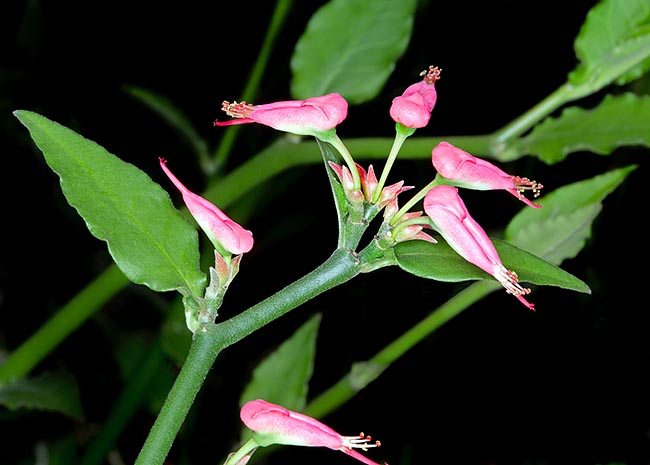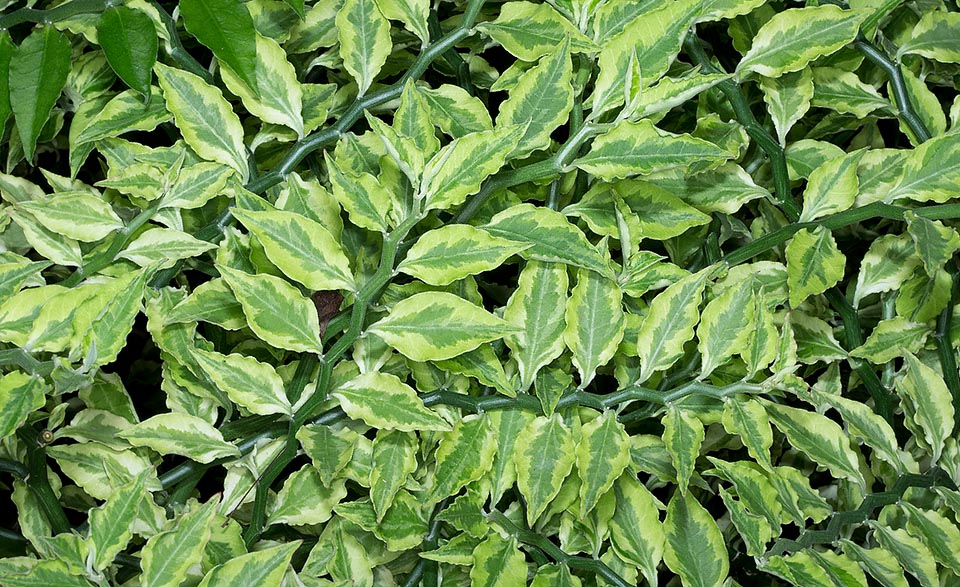Family : Euphorbiaceae

Text © Pietro Puccio

English translation by Mario Beltramini

In Euphorbia tithymaloides the cyathia are protected by a red or purple pink involucre © Giuseppe Mazza
The species is native to Bahamas, Belize, Bermuda, Brazil (Acre, Amazonas, Amapá, Espirito Santo, Minas Gerais, Pará, Rio de Janeiro, Roraima, Rondônia, São Paulo, Tocantins and Trindade), Colombia, Costa Rica, Cuba, Dominican Republic, Dutch Antilles, Ecuador, El Salvador, Guatemala, Guyana, Haiti, Honduras, Jamaica, Leeward Islands, Panama, Puerto Rico, Surinam, Trinidad and Tobago, Turks and Caicos Islands, USA (Florida), Venezuela, Venezuelan Antilles and Windward Islands, where it grows in the thickets and dry deciduous forests or on stony and rocky soils in full sun, often close to the sea.
The genus gets its name from Euphorbus, personal physician of Juba II (52 BC – 23 AD), King of Numibia, who dedicated to the king these plants in a work where it described its medicinal virtues; the name of the species is the combination of Tithymalus and of the Greek suffix “-οειδής” (-oeidés), from “εἶδος” (êidos) = shape, look, therefore similar to the genus Tithymalus.
Common names: bird cactus, Christmas candle, devil’s backbone, Japanese poinsettia, Jewbush, redbird cactus, redbird flower, gibbo cactus, slipper flower, slipper plant, zigzag plant (English); echine du diable, herbe à cors, pantouflier (French); dois amores, dois-irmãos, picão, sapatinho-do-diablo, planta-zique-zaque, sapatinho-do-judeu, sapatinho-dos-jardins, (Portuguese-Brazil); cacto cardenal, cacto zapatilla, dictamo real, gallito colorado, ipecacuana, itamo real, pie de niño, pie de santo, zapatilla del diablo, zapatito de la Virgen, zapatito rojo (Spanish); Teufelsrückgrat (German).
The Euphorbia tithymaloides L. (1753) is an unarmed evergreen perennial species with sinuous, succulent, milky cylindrical stems, green in the youngest part, greyish in the oldest one, ramified at the base, 0,4-2 m long. The leaves, sessile or on a short petiole, are simple, alternate, distichous, coriaceous, slightly fleshy, oblong to elliptic-ovate with slightly waved borders and keeled below, 6-10 cm long and 2-4 cm broad.
The cyathia, the typical inflorescences of the Euphorbiaceae, grouped in cymes at the extremities of the branches, are formed by a female flower reduced to a pistil, that is, without calyx and corolla, as well as the male flowers surrounding it, reduced to a stamen, enclosed by a particularly shaped involucre, red or purple pink, 0,8-1,5 cm long; the flowers, rich of nectar, are pollinated by the hummingbirds.
The fruit is a trilobed dehiscent capsule of 0,6 cm of breadth initially green, then brown when ripe, containing three ovoid seeds of about 4 mm of diameter of greyish brown colour. It reproduces by seed and easily by cutting, after having dried up the cut for 2-3 days, in just humid sandy loam.

Cultivated as ornament, like other Euphorbiaceae has a white latex particularly irritant © Giuseppe Mazza
Amply diffused species in nature and cultivated in the tropical and subtropical regions preferably in full sun, even if it bears a slight shade, as isolated specimen, in mass or for borders, in “desertic” gardens, on particularly draining soils; it does not stand water stagnations and temperatures around the 0 °C, is not for exceptional and very short period, and can overcome long drought periods, losing in such case, the leaves.
Elsewhere, it is cultivated in pot, preferably small, in perfectly draining, sandy, loam, in position as much as possible luminous, with lowest winter temperatures not under the 14 °C and moderate and spaced watering, in particular in presence of low temperatures. Much appreciated, and usually present in the collections of succulents, the variety with the leaves streaked in white and carmine red.
The latex contains highly irritant substances; the contact with the skin may cause serious dermatitis in the most sensitive subjects, in particular in the eyes where it can cause temporary blindness, it is therefore appropriate to wear gloves in the operations on the plant which might cause an overflow of latex; in case of contact, to wash repeatedly with water and soap and in the most serious cases to seek medical attention; all parts of the plant are particularly toxic if ingested, the ingestion of even few seeds causes persistent nausea, vomit and diarrhoea.
Synonyms: Tithymalus myrtifolius (L.) Mill (1768); Euphorbia myrtifolia (L.) Lam. (1788); Euphorbia carinata Donn (1811); Crepidaria myrtifolia (L.) Haw. (1812); Pedilanthus tithymaloides (L.) Poit. (1812); Crepidaria carinata (Donn) Haw. (1819); Crepidaria subcarinata Haw. (1819); Euphorbia anacampseroides Descourt. (1822); Pedilanthus myrtifolius (L.) Link (1822); Euphorbia canaliculata Lodd. (1823); Pedilanthus canaliculatus (Lodd.) Sweet (1826); Pedilanthus carinatus (Donn) Spreng. (1826); Pedilanthus subcarinatus (Haw.) Sweet (1826); Pedilanthus myrsifolius (L.) Raf. (1838); Pedilanthus houlletii Baill. (1861); Pedilanthus fendleri Boiss. (1862); Tithymaloides fendleri (Boiss.) Kuntze (1891); Tithymaloides houlletii (Baill.) Kuntze (1891); Tithymaloides myrtifolia (L.) Kuntze (1891); Pedilanthus pringlei Rob (1894); Pedilanthus gritensis Zahlbr (1897); Pedilanthus deamii Millsp. (1913); Pedilanthus campester Brandegee (1914); Pedilanthus petraeus Brandegee (1924); Pedilanthus ierensis Britton (1926); Tithymalus deamii (Millsp.) Croizat (1937); Tithymalus ierensis (Britton) Croizat (1937); Tithymalus petraeus (Brandegee) Croizat (1937); Tithymalus pringlei (Rob.) Croizat (1937); Tithymalus tithymaloides (L.) Croiza (1937); Tithymalus villicus Croizat (1937); Pedilanthus camporum Standl. & Steyerm. (1944).
→ To appreciate the biodiversity within the family EUPHORBIACEAE please click here.
